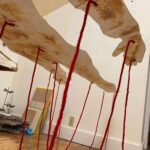Movement
6

provocation
In her Movement 5, Binda created an installation of a life-size paper body suspended over an anatomically correct arrangement of clay organs

In her Movement 5, Binda created an installation of a life-size paper body suspended over an anatomically correct arrangement of clay organs
It is being such a pleasure to collect the seeds and blossoms of the different vines that are twining through this project.
Movement 5 marked a major shift for me in this project. When I walked upstairs to Binda’s studio and saw my own (paper) body suspended from the ceiling and grounded to the floor, not just red threads of aliveness but thick red yarn of aliveness coiling down open all my (her, our) organs laid bare beneath — the game had changed. Binda’s vision, and her craft, was an invitation to something so much larger. I had to step up. I wanted to become.
Standing looking at her installation, I had spoken aloud the words, “the body and the story of the body.” The solidity of the organs, the innards in their body-cavity colors, juxtaposed with the delicate paper outline that hung above, literally scribed with words and flowers. The body and the story of the body. How do those live together, inform each other? Are they separate, or inseparable?
The antecedents to some of the lyrics:
A few days after our fifth Cross, my son got a tattoo of a dahlia and a hibiscus on his forearm. I wanted to know why flowers, why those flowers. Surely there was a story? “They’re pretty,” he said. “When I’m eighty, they’ll still be pretty. It doesn’t have to mean anything more than that.” On the contrary, I thought, what could mean more that?
My husband has a tattoo, too — a yin-yang symbol on the back of his shoulder. It’s been there for years, though, and it’s spread and faded some, so it no longer looks like the yin-yang. Instead, it looks to me like a moon.
Many of these lyrics derive from advice or direction offered by Jonathan Stancato of the Inside Voice studio.
The middle, spoken words are all quotes from Binda’s previous movements.
The Body and the Story of the Body
The body and the story of the body
Let the moon shine off your shoulder
Let your belly fill out
Let your arms be inked with flowers
Let yourself not need to know the notes
before you sing out
Let your voice be yours and ours
We are come to sing the praises of the skin that keeps us in
and the guts that tell us who to trust, if we listen
The body knows that it’s the same thing as the soul
holy organs, sacred bones
Tell the body the story of the body
It was flowers who invented love
Is the ability to laugh at pain a sign of having moved through the pain?
A visual vibration response
We are at stake to each other, sporing partners, bound together
Melodious Thunk
Line and color and line and color and line and color and line
What if nothing needed knowing
What if that was how we lived
What if truth is improvised
What if beauty is the only explanation I can give
Just like now is the only time
Let us rise to give our thanks to the hysterics and the hags
Who had wings tattooed across their backs and flew away
The body knows that it’s the only real home
where we come from, where we’re going
The body and the story of the body
The body don’t need
The body don’t need no
The body don’t need no words
The body don’t need no
The body don’t need no words